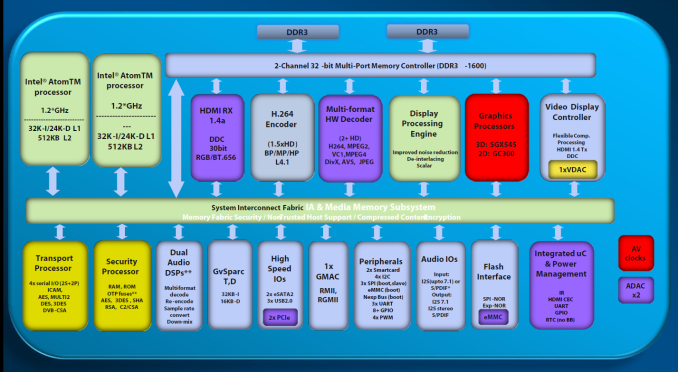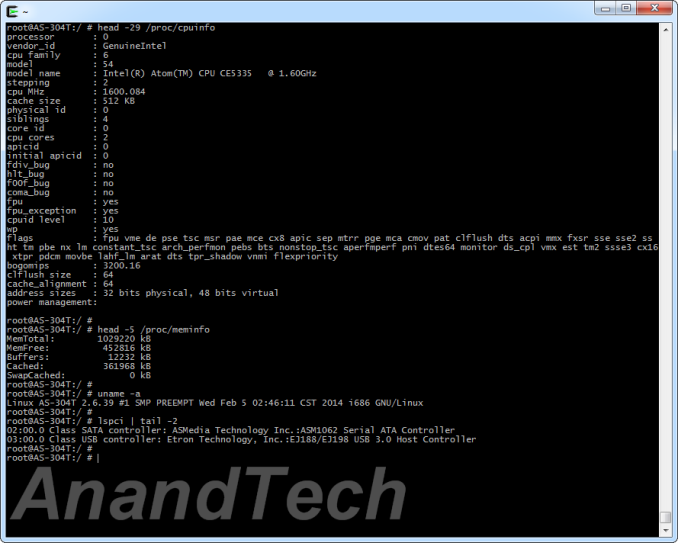Asustor AS-304T: 4-Bay Intel Evansport NAS Review
by Ganesh T S on March 26, 2014 11:15 AM ESTHardware Aspects & Usage Impressions
The Asustor AS-304T comes with a built-in PSU, which reduces the unit's footprint (thanks to the absence of a power brick). The unit maintains the standard industrial design for a 4-bay desktop NAS in the tower form factor, and the choice of materials for the chassis as well as the drive bays is quite acceptable. The front side of the unit has the power button the top and a USB 3.0 slot at the bottom on the left side, while the four bays (and what appears to be a slot for a display) make up the right side. On the rear side of the unit, we have a single 120mm fan , a RJ-45 Ethernet port, and two USB 2.0 ports. Above the USB 2.0 ports, we have a HDMI 1.4a and a USB 3.0 port as well as a 3.5mm audio jack. Note that, unlike the Thecus N2560, we don't have an optical SPDIF port. This shouldn't be taken as a negative, since most multimedia use-cases involve transmitting audio through the HDMI port nowadays.
Platform Analysis:
The block diagram below gives the layout of the Intel CE5335 SoC. Typically, x86 NAS units come with dual network ports (capable of port trunking), but units based on Evansport (such as the AS-304T) don't have that because of the lack of support in the platform. This is acceptable, considering that Evansport is supposed to cater to home consumers who want to use the NAS as a media server.
The other important aspect is the available high-speed I/Os. In a NAS platform based on the CE5335, the two SATA ports and two PCIe 2.0 lanes can support up to 4-bays with the help of a SATA - PCIe bridge. There is no native USB 3.0 support in the SoC. Therefore, the AS-304T's USB 3.0 support definitely from a USB 3.0 to PCIe bridge. It can be guaranteed with this information that the platform would not be able to support all the peripherals at full speed because of either the multiplexing of PCIe lanes and / or throttling the connection of the peripheral to the SoC by using lesser number of PCIe lanes than necessary.
One option to determine the components on the board would have been disassembling the unit. Fortunately, Asustor provides SSH access. The screenshot below exposes some of the hardware aspects of the AS-304T.
The two additional SATA ports are provided by the ASMedia ASM1062 which bridges two SATA 6 Gbps ports to a single PCIe 2.0 lane. The USB 3.0 ports are enabled by the Etron EJ188 which bridges two USB 3.0 ports to a single PCIe 2.0 lane.
Setup & Usage:
After connection to the network, the unit obtains a DHCP address (even in diskless mode) and could be setup using the web UI at http://<AS-304T-IP>. The setup process is straightforward. At least one of the bays needs to be populated. The firmware (Asustor Data Master - ADM) can either be uploaded from the local disk, or, in the case of an active Internet connection, downloaded directly from Asustor's site. The UI helpfully provides updates on the progress of the process. After a restart, the user is provided with an option to accept default settings (depending on the network and number of initial hard disks) or manually configure all the settings. An option is also provided to register for an Asustor ID (necessary to be able to download apps for the NAS from Asustor's marketplace).
The UI on the AS-304T is reminiscent of operating a mobile device, with apps and links to settings laid out in a grid fashion. The Storage Manager helps configure / migrate / expand RAIDed volumes and set up iSCSI targets. It also handles disk info (S.M.A.R.T). Options are available to create users and user groups for fine-grained access control to shared folders. The services section allows configuration of CIFS, NFS, AFP, FTP and WebDAV.
The App Central section allows users to install apps in addition to those that come pre-installed with ADM. The Backup & Restore section allows configuration of rsync as well as other backup options (FTP, external device, cloud etc.). The 'Cloud Connect' feature allows configuration of access to the NAS from an external network (either through port forwarding or relay access via Asustor's servers). The System Information option's Dr. Asustor feature provides a single interface to maintain the health of the NAS (including network connectivity, firewall configuration, HDD bad block scanning and backup configuration). A very pleasing interface to monitor the resource usage is also available.
In order to use the media-centric features (such as XBMC), it is necessary to enable the 'Media Mode' through the UI. This dedicates a portion of the system memory (around 256MB) to running X-Windows and related apps (including Chrome and XBMC) on a display connected to the HDMI port of the NAS. Asustor also sells a separate IR remote for easy navigation in XBMC. In any case, we found that standard USB HID-compliant input devices (including wireless keyboard/mouse combos) could be used to control the NAS in Media Mode.
Our testing sequence started with the insertion of a single disk and configuring it in JBOD. After adding another disk, we were able to migrate to RAID-1. The data remained online (as expected) during the process. Adding another drive allowed us to migrate to RAID-5. Addition of yet another disk helped in testing out RAID-5 expansion. Throughout all these operations, the NAS kept the data accessible and the processes got done without any hitch. We tested RAID-5 rebuild by yanking out a disk during operation and re-inserting it. The rebuild process was also uneventful. On the whole, we were very satisfied with the unit's handling of storage operations (including handling of disk failures).




































34 Comments
View All Comments
bernstein - Wednesday, March 26, 2014 - link
Does this NAS finally have ECC?? (like for instance an ECC enabled ZFS linux fileserver)do people actually know how many digital photos get corrupted in 20years of not using ECC?
protomech - Wednesday, March 26, 2014 - link
No. How many digital photos are corrupted due to lack of ECC?I assume you're talking about ECC on the storage pools, not ECC in the computer main memory..
manmax - Wednesday, March 26, 2014 - link
He mentions ZFS so I guess he means the data integrity checking and self-healing of corrupted data features of ZFS and Btrfs. This is probably my main reason to go with ZFS or Btrfs for NAS devices especially when used for backup purposes.Overtime, bits can just randomly flip on a hard drive (the drive is still perfectly fine). For example, old photos, music and videos all of sudden don't open or are distorted. RAID (at least most implementations I've seen) doesn't save you from random bit flipping. It's mainly for keeping a server up if a drive completely fails, not from file corruption.
Gigaplex - Saturday, March 29, 2014 - link
I've had file system corruption because a stick of RAM went bad, affecting the file system cache. My next build will have ECC RAM.hoboville - Thursday, March 27, 2014 - link
Without ECC, a scrub of a ZFS pool can corrupt your entire dataset. It happens, a lot. Regardless, ZFS provides better features like ARC, and full CoW. Ext4 RAID would be viable too, but for an average home user, ZFS is going to be too much because it has higher hardware requirements, requires a more advanced user, and will generally cost more money. Like Ganesh said, these cheapo units are good for simple HTPC stuff.Oyster - Wednesday, March 26, 2014 - link
Good work, Ganesh. Thanks for incorporating our feedback and including competitor benchmarks as standalone performance graphs.ganeshts - Wednesday, March 26, 2014 - link
Thanks! The suggestion made sense, but we were waiting till we got enough units reviewed with the new methodology in each category (splitting by number of bays)Flunk - Wednesday, March 26, 2014 - link
Is Asustor in any way related to ASUS?ganeshts - Wednesday, March 26, 2014 - link
Yes, they are a subsidiary of AsusDirector12 - Wednesday, March 26, 2014 - link
How does it stack against the Asustor 604T?